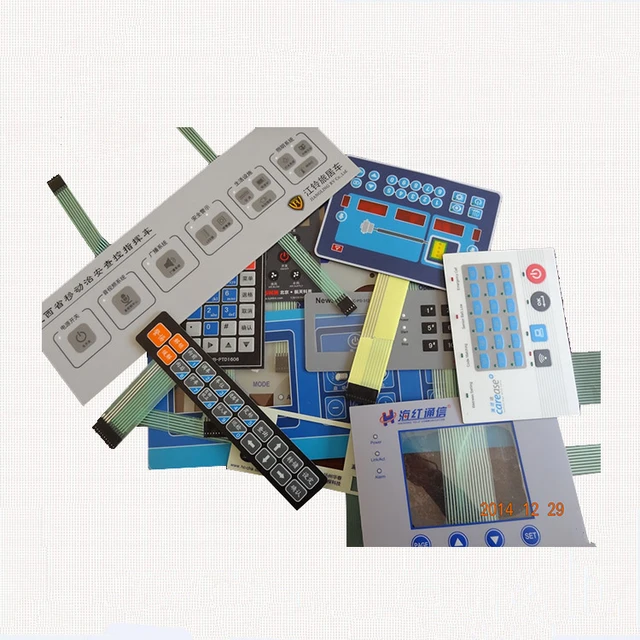How Membrane Switches Are Shaping the Future of Electronic Interfaces
How Membrane Switches Are Shaping the Future of Electronic Interfaces
Blog Article
Recognizing Membrane Switches Over: The Key to Resilient and Reputable Controls

What Are Membrane Layer Buttons?
Membrane buttons are an advanced service in the realm of interface modern technology, combining functionality and style seamlessly. These tools offer as an interface between individuals and electronic systems, integrating a number of parts into a small style. Commonly built from flexible, thin layers of materials, membrane switches are developed to reply to touch, allowing users to connect with machinery and electronic tools efficiently.
The key elements of a membrane button consist of a published circuit layer, visuals overlay, and a spacer layer that stops unexpected activation. The graphic overlay can be customized to mirror brand name identification or user preferences, boosting appearances while making certain functionality. Membrane buttons are commonly made use of in different applications, including clinical tools, consumer electronic devices, and industrial equipment, owing to their durability and resistance to environmental aspects such as wetness and dirt.
One of the vital benefits of membrane layer switches is their capacity to stand up to wear and tear, making them suitable for high-traffic atmospheres. Additionally, they are light-weight and call for very little room, permitting for innovative styles in product development. Generally, membrane switches over represent a efficient and sensible option for modern digital interfaces, weding modern technology with user-centric design principles.
Just How Membrane Layer Changes Work
The procedure of membrane layer switches joints on a simple yet reliable device that converts customer input into digital signals. When a customer presses the button, the leading layer deforms, permitting a conductive component in the circuit layer to make contact with a corresponding conductive pad on the underside of the visuals overlay.
The design of membrane layer buttons can vary, but they usually include domes or responsive components to provide responses to the customer, improving the total experience - membrane switch. The products used in membrane layer switches, such as polyester or polycarbonate, contribute to their toughness and resistance to environmental factors, including wetness and dust. The published circuits are normally enveloped, which safeguards them from wear and tear over time.
Advantages of Membrane Switches

Additionally, membrane buttons are recognized for their sturdiness. Constructed from robust materials, they are immune to dust, wetness, and physical wear, which dramatically prolongs their lifespan compared to conventional mechanical buttons. This durability makes them especially appropriate for high-traffic atmospheres and applications needing longevity.
One more significant advantage is the simplicity of cleansing and upkeep. The smooth surface area of membrane switches over lessens dirt build-up and is usually resistant to spills, making them optimal for settings that need constant sanitization.
Additionally, membrane switches use a structured account, resulting in a thinner design that can be incorporated right into numerous devices without adding mass. This attribute not only improves the visual charm however also contributes to an extra ergonomic item style.
Applications of Membrane Layer Switches
Functional and straightforward, membrane layer buttons discover applications across a large range of industries, consisting of medical devices, consumer electronic devices, and industrial equipment. In the clinical field, these buttons are indispensable to tools such as diagnostic equipment, client tracking systems, and infusion pumps, where reliability and convenience of cleaning are crucial. Their capability to maintain and stand up to rough atmospheres capability makes them suitable for such applications.

In customer electronic devices, membrane layer buttons are made use of in items like microwaves, cleaning makers, and push-button controls - membrane switch. Their sleek layout enables instinctive customer interfaces, enhancing the general individual experience while offering longevity and resistance to damage
Commercial tools also profits from membrane switches, specifically in control panels for machinery and automation systems. These buttons offer protection his response against dust and wetness, making sure regular efficiency in difficult environments. Their personalized functions permit manufacturers to customize them to specific functional needs, enhancing effectiveness and capability.
Choosing the Right Membrane Switch Over
When picking a membrane button, it is vital to consider various aspects that influence efficiency and viability for specific applications. The main factors to consider include environmental conditions, responsive feedback, sturdiness, and style specifications.
First, evaluate the operating environment; switches subjected to moisture, chemicals, or severe temperature levels call for certain products to guarantee longevity and functionality. Next off, review the need for tactile feedback. Depending on customer communication, some applications may benefit from a responsive reaction to confirm activation, while others might favor a non-tactile style for aesthetic factors.
Durability is one more critical aspect; membrane layer switches must be developed to withstand constant use, impacts, and abrasion. Ensure the selected switch can withstand the anticipated lifecycle, particularly in high-usage scenarios.

Final Thought
Finally, membrane layer changes work as crucial parts in the design of dependable and long lasting control systems throughout different industries. Their portable layout, integrated with durable building and construction and personalized features, enhances individual communication while ensuring long life in requiring atmospheres. The flexibility of membrane switches allows for tailored solutions that fulfill certain functional requirements, reinforcing their value in modern technology. As sectors continue to develop, the relevance of integrating effective membrane layer switch options can not be overstated.
Membrane layer switches over stand for an essential element of modern interface style, mixing performance with Go Here resilience in various applications.Membrane layer buttons are a sophisticated solution in the world of user interface technology, integrating functionality and layout effortlessly. Typically constructed from versatile, slim layers of products, membrane layer buttons are made to respond to touch, allowing customers to engage with equipment and electronic devices properly.
The design of membrane layer switches can differ, however they commonly include domes or tactile aspects to offer comments to the customer, boosting the overall experience.In final thought, membrane layer switches over serve as necessary components in the style of reliable and sturdy control systems throughout different sectors.
Report this page